Pachaug State Forest is Connecticut’s largest and grandest State Forest, encompassing 26,477 acres and six towns – Voluntown, Sterling, Plainfield, Griswold, North Stonington, and Preston. Pachaug offers miles of scenic hiking and beautiful ponds for hikers and visitors to explore any time of year. The park lies on the Rhode Island border in New London Country.

A network of trails weaves through the wooden forests, where you can glimpse the wildlife within the
park
.
©gscuriouseye/Shutterstock.com
Connecticut officially founded the forest in 1928, but the state received most of the land from purchases made later during the Great Depression. The forest gets its name from the Pachaung River, which runs through its center. A network of trails weaves through the wooden forests, where you can glimpse the wildlife within the park.
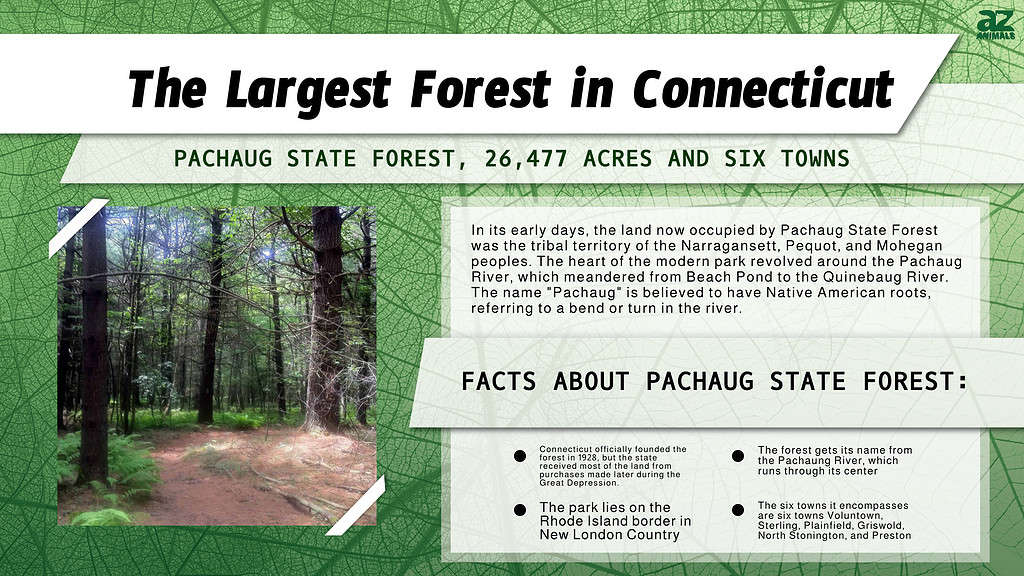
Wildlife in Pachaug State Forest
White-tailed Deer
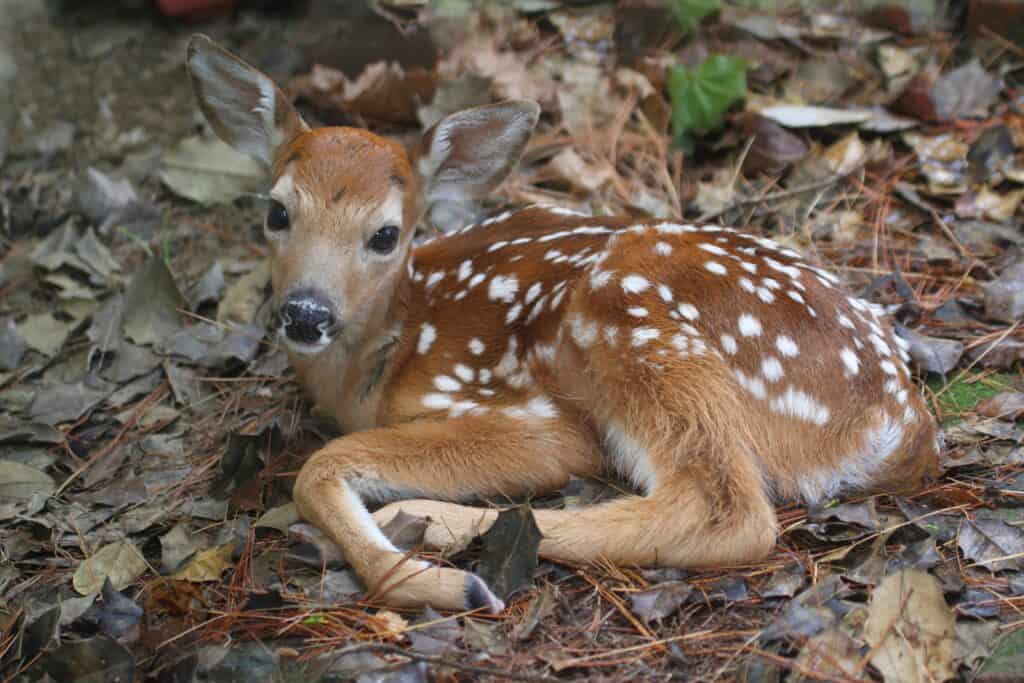
White-tailed deer
are herbivores.
©Steve Byland/Shutterstock.com
Scientific name: Odocoileus virginianus
You can spot these graceful and common woodland mammals throughout the forest. They are known for their distinctive white tail foraging in meadows or quietly moving through the trees. White-tailed deer are herbivores that weigh 110 to 300 pounds and stand 6 to 7.75 feet tall. Their average life span stretches from six to 14 years.
In the summer, these deer usually live in green fields and luscious meadows using clumps of broad-leaved and coniferous forests for shade. During the winter, they generally stay in the woods. These herbivorous deer graze on most available plant foods. Their strong and unique stomachs allow them to digest a varied diet, including leaves, twigs, fruits, nuts, grass, corn, alfalfa, lichens, and other fungi.
Eastern Coyote
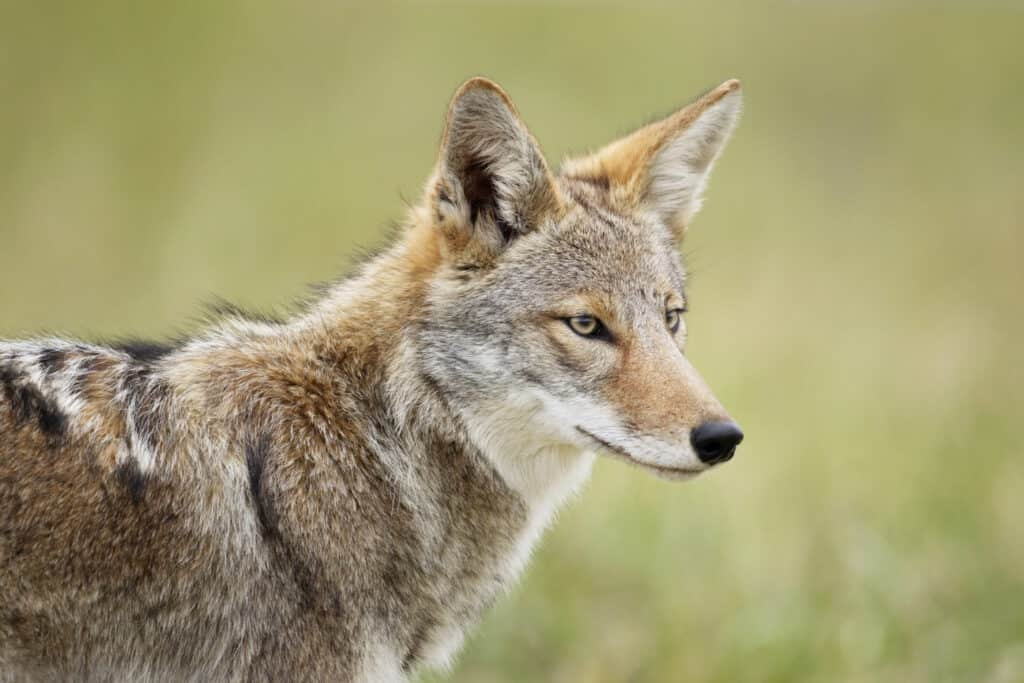
Pachaug State Forest provides suitable habitat for Eastern coyotes, a species known for their adaptability.
©Paul Tessier/Shutterstock.com
Scientific name: Canis latrans var
Pachaug State Forest provides suitable habitat for Eastern coyotes, a species known for their adaptability. These canines are larger than their western counterparts and are skilled hunters, feeding on small mammals and birds and occasionally scavenging for food.
The eastern coyote is a wild North American canine hybrid with coyote and wolf parentage. The hybridization likely occurred in the Great Lakes region as western coyotes moved east.
It reaches heights of 40-50 inches, weighs 30-40 pounds, and lives in various habitats, including forests, fields, farmlands, and suburban/urban areas. Historically, people only found them in the Western United States, but coyotes have rapidly expanded their range and roamed throughout the U.S. and Southern Canada. Their diet consists of small mammals, insects, snakes, and fruit. Wolves and Mountain Lions are vicious predators of coyotes.
Red Fox
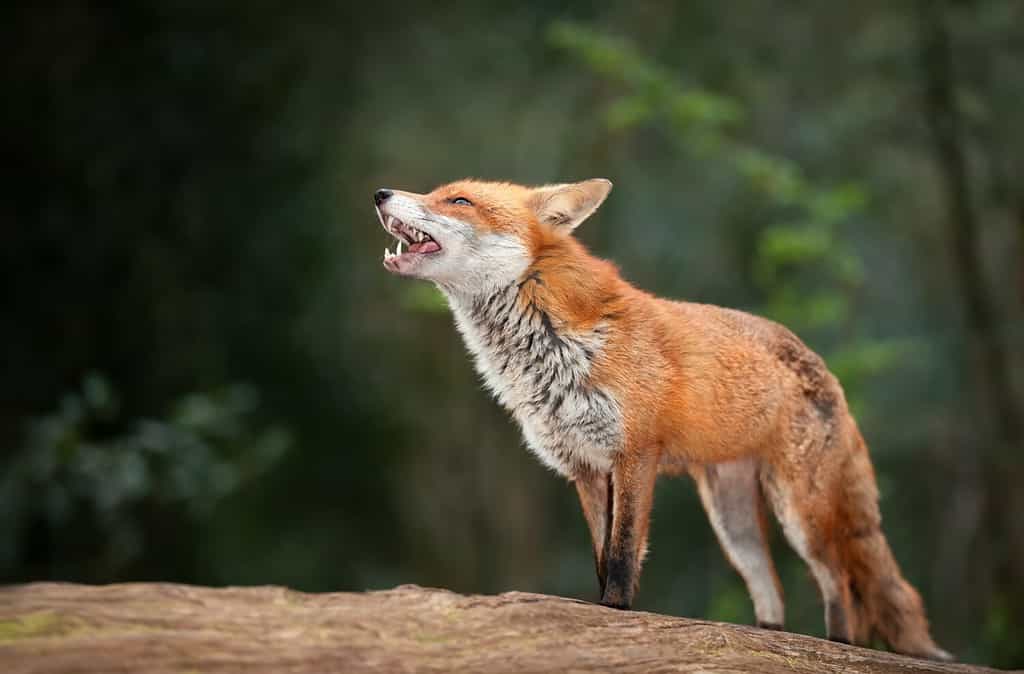
Fox vocalizations include yips and barks, which can travel great distances.
©Giedriius/Shutterstock.com
Scientific name: Vulpes vulpes
The forest is also home to the red fox, a small carnivorous mammal known for its reddish-orange fur. Red foxes are nocturnal, hunting for small rodents and rabbits in the early morning or evening. The red fox is the biggest in terms of the size of the true foxes, and this fox is the most widely found member of Carnivora, present across the entire Northern Hemisphere, including most of North America.
This species of fox is a survivalist in the wild, having to adapt to life near humans. It has learned to thrive in many climates and habitats, from steep mountain cliffs to flat, featureless deserts. The red fox seems like a natural part of our landscape, having adapted to life near humans yet retaining its wild enigmatic nature.
Wild Turkey

Turkeys can see better than humans.
©iStock.com/Robert Winkler
Scientfic name: Meleagris gallopavo silvestris
Pachaug State Forest supports a healthy population of wild turkeys. These large birds are known for their impressive plumage, and you can see them foraging on the forest floor or perched in trees.
Eastern Turkey is a large ground-dwelling bird native to North America. It primarily inhabits forests with hardwood trees and has a foraging behavior involving searching for food near the ground. Additionally, Eastern Turkeys prefer to roost in flocks or groups, often perched high in tall trees. These birds are known for their vocal nature, emitting distinct sounds to communicate and express themselves. These birds are loud and speak amongst themselves with various noises.
Eastern Cottontail Rabbit
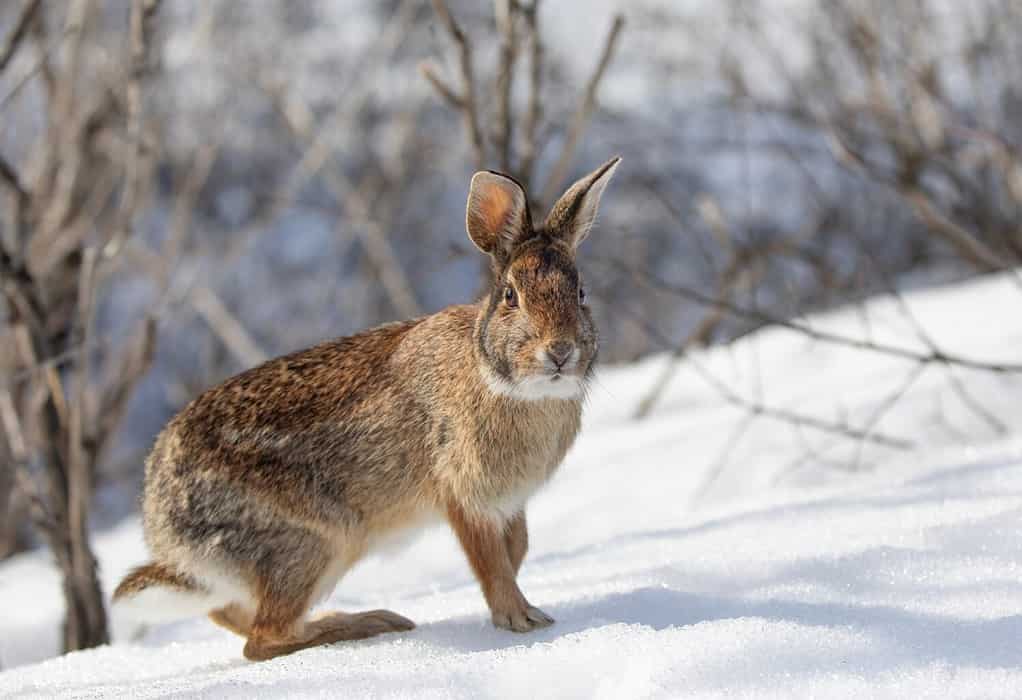
The Pachaug forest provides a suitable habitat for
Eastern cottontail
rabbits.
©Jim Cumming/Shutterstock.com
Scientific name: Sylvilagus floridanus
The Pachaug forest provides a suitable habitat for Eastern cottontail rabbits. These small mammals are known for their fluffy white tails darting across open areas or seeking shelter in thickets.
Initially, you could not find the rabbit in New England, but it lives and competes for habitat there with native New England cottontail. An eastern cottontail’s perfect habitat includes open grassy areas, clearings, and old fields supporting abundant grasses and herbs with shrubs in the area or edges to cover.
Raccoon
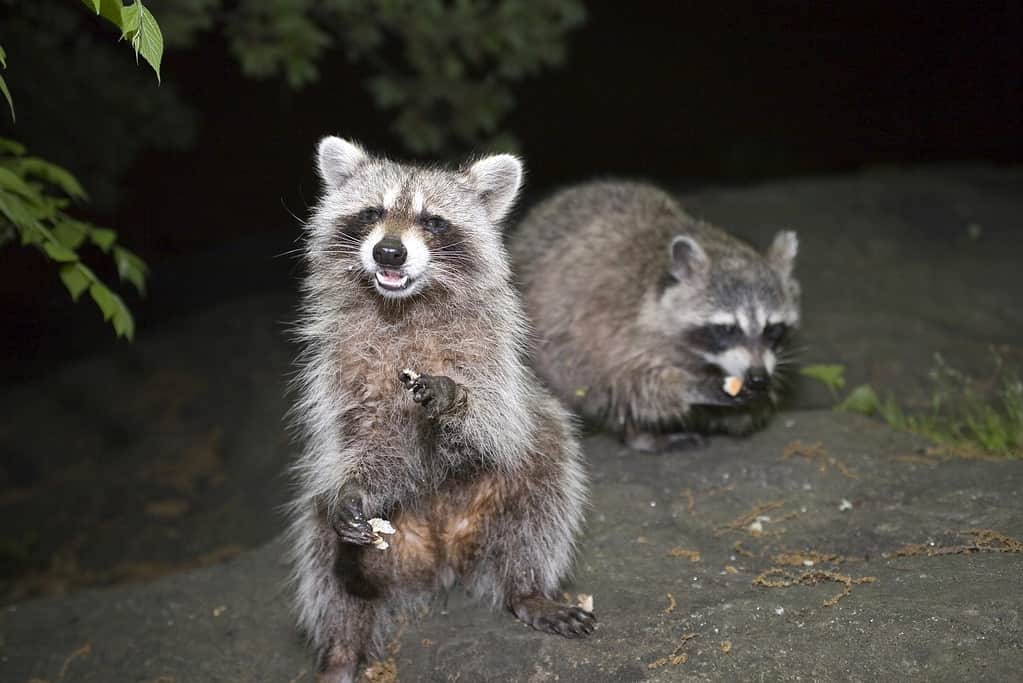
Raccoon comes from native Powhatan, meaning
“animal
that scratches with its hands.
©iStock.com/eddtoro
Scientific name: Procyon lotor
Raccoons are common in Pachaug State Forest and are easily recognizable by their black mask-like facial markings and ringed tails. They are skilled climbers often found near water sources, searching for food. Raccoon comes from native Powhatan, meaning “animal that scratches with its hands.” The Powhatans were native to Virginia.
People have interacted with raccoons for as long as humans have settled in the Americas. Mythology considers raccoons a significant object and food source for Native Americans and European settlers alike due to their fur’s ability to turn into hats and coats; entire industries sprung up around trapping the raccoon.
Seasonal activities in Pachaug State Forest
In Season
During the peak season, Pachaug State Forest offers a variety of activities for outdoor enthusiasts.
Hiking
Hiking enthusiasts can explore the extensive network of scenic trails that wind through the enchanting woodlands of Eastern Connecticut. For a more pleasant experience than its name implies, embark on the Mt. Misery trail, which rewards hikers with breathtaking elevated views of the surrounding forest. Alternatively, take the Green Falls trail, which forms a loop around the picturesque ponds within the forest. Some other popular trails include
The Pachaug Trail runs about 30 miles (48 km) in an east-west route following a north horse-shoe curve. It begins at the northern end of Pachaug Pond and ends at Green Fall Pond.
The Nehantic Trail is a route just under 15 miles (24 km) that begins at Green Fall Pond near the Pachaug Trail trailhead and runs northwest to RT 201 near the Pachaug River.
The Quinebaug Trail runs North-South for about 7 miles (11 km) from the junction of Breakneck Hill Road and the Nehantic-Quinebaug Trail Crossover to its northern terminus at Spaulding Road.
The Narragansett Trail runs from the southwest to the northeast, starting from Lantern Hill in North Stonington. The Narragansett Trail leaves the State Forest at the Connecticut/Rhode Island boundary; it enters the Yawgoog Scout Reservation in Rhode Island and later ends at Ashville Pond in the village of Canonchet in Hopkinton, Rhode Island.
Visitors in July can visit the Rhododendron Sanctuary, a short and scenic walk showcasing the diverse plants and wildlife within the forest. This trail is wheelchair accessible and includes a planked wooden boardwalk section.
Hunting
The park also provides ample hunting opportunities. With its expansive areas, hunters can pursue various games, from deer to smaller animals like rabbits, coyotes, pheasants, and foxes. The hilly terrain of the forest adds an element of excitement to each hunting expedition, offering great cover for the game.
Please note that hunting in Pachaug State Forest requires a valid Connecticut state hunting license, and Rangers enforce all hunting regulations. To ensure compliance with designated hunting areas, refer to the hunting map provided by the park.
Fishing
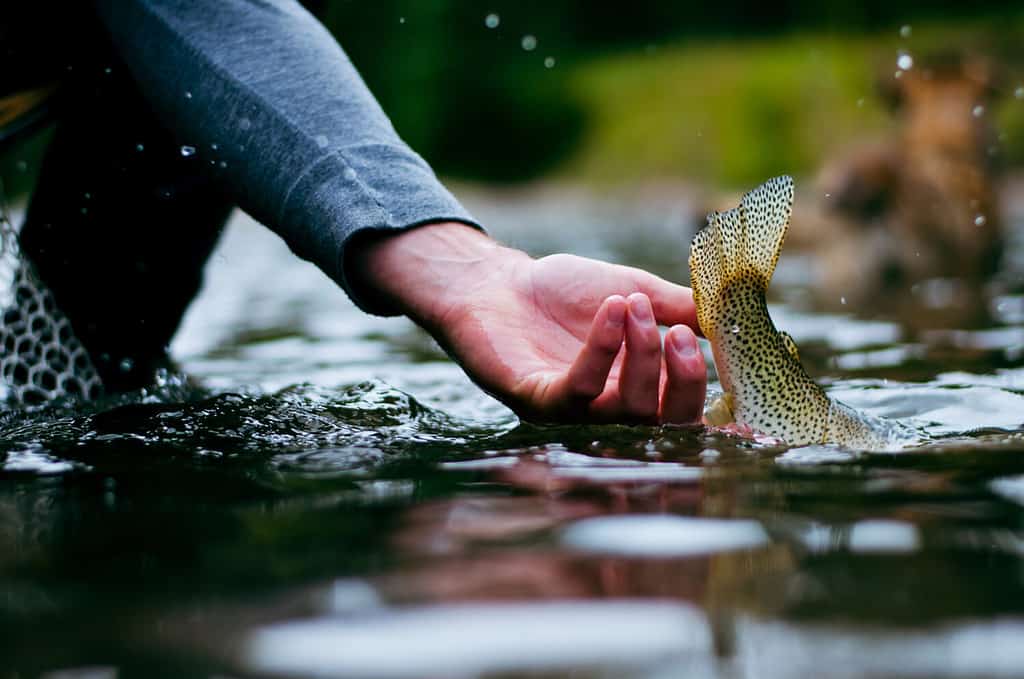
Green Falls Pond and Beachdale Pond, easily accessible from the Green Falls campground, offer a chance to catch
trout
, pickerel, bass, and bullhead.
©Jennifer de Graaf/Shutterstock.com
For fishing enthusiasts, Pachaug State Forest boasts numerous streams and ponds, providing endless possibilities for angling. Whether you visit during any season, you’ll find plenty of fish to keep you occupied. Green Falls Pond and Beachdale Pond, easily accessible from the Green Falls campground, offer a chance to catch trout, pickerel, bass, and bullhead. These ponds are also within walking distance of the Mt. Misery campground.
Please be aware that fishing in Pachaug State Forest requires a valid Connecticut state fishing license.
Off-Season
During the off-season, there are additional activities to enjoy in the forest.
Horseback Riding
Equestrian enthusiasts can explore the forest’s scenic beauty on horseback through three designated loops. Ranging from six to 14 miles in the distance, these trails ensure plenty of terrains to discover. Since the trails are meant explicitly for horseback riding, there’s no need to worry about encountering hikers. The horseback riding trails are open year-round but particularly stunning in spring and fall. All three loops connect to the Frog Hollow Horse Camp.

If you’re hiking and you see people out on horses, be mindful of their space and try not to spook the horses when you pass.
©Canon_photographer/Shutterstock.com
Snowmobiling
In winter, the vast network of trails transforms into a winter wonderland, perfect for snowmobiling. Explore the snow-covered forests and catch glimpses of the park’s winter wildlife. Connect with a trail network that extends throughout the region for longer rides. Remember that you share the trails with hikers, so exercise caution, especially in low visibility conditions.
Motorcycle Riding
If you prefer a faster-paced adventure, bring your motorcycle and take advantage of the 58-mile motorcycle trail that traverses Pachaug State Forest year-round. The trail offers a mix of muddy paths and paved roads, weaving its way through the forest and public routes. Please stay on the designated trail, separate from the hiking trails. Adhere to speed limits as Rangers monitor the trails. To access the trail, ensure your motorcycle is registered.
Whether you visit during the in-season or off-season, Pachaug State Forest offers abundant outdoor activities for all nature lovers.
History of the Park
Pachaug State Forest, the largest state forest in Connecticut, encompasses approximately 26,477 acres and spans multiple towns in eastern Connecticut. Surprisingly, this natural gem is intertwined with Voluntown’s industrial past.
In its early days, the land now occupied by Pachaug State Forest was the tribal territory of the Narragansett, Pequot, and Mohegan peoples. The heart of the modern park revolved around the Pachaug River, which meandered from Beach Pond to the Quinebaug River. The name “Pachaug” is believed to have Native American roots, referring to a bend or turn in the river.
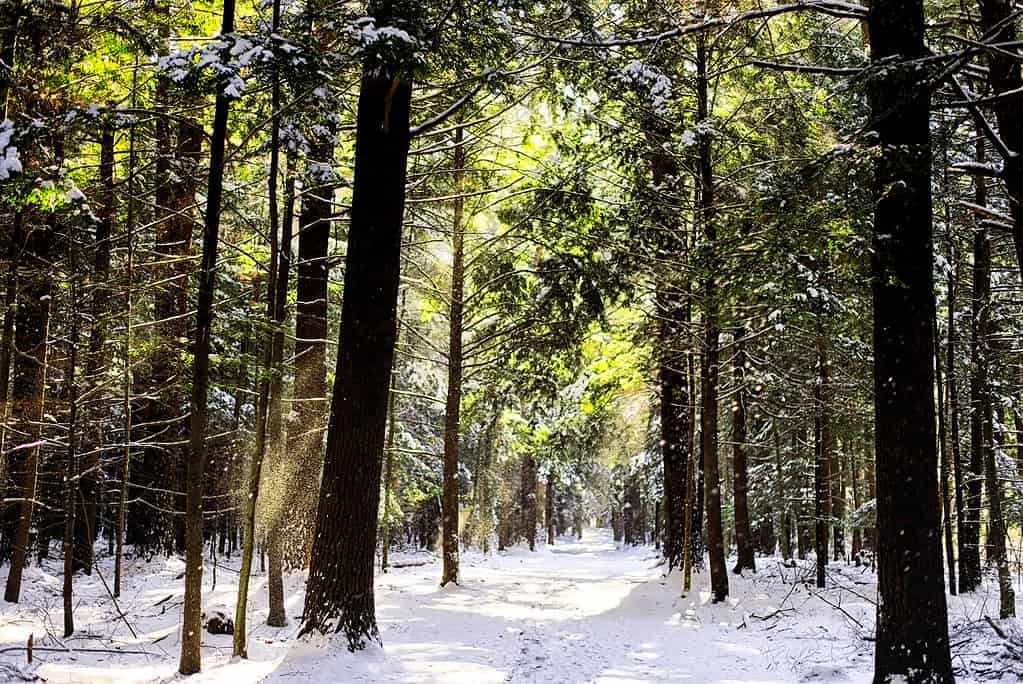
Pachaug State Forest in Connecticut is beautiful after it snows.
©iStock.com/Daniel Hanscom
Settlers realized the area’s industrial potential due to its abundant water resources, which powered mills. During the 19th century, the Industrial Revolution brought numerous textile businesses to eastern Connecticut, and Voluntown was home to one of the prominent firms, the Briggs Manufacturing Company. In 1926, Briggs ceased operations, and two years later, the state acquired 1,100 acres of the company’s property, designating it as Pachaug State Forest for preservation.
Through dedicated fundraising efforts over the following decade, the park expanded to cover 12,000 acres. People made additional land acquisitions through the Recreation and Natural Heritage Trust Fund, a state initiative to acquire lands to expand Connecticut’s park system. In the 1930s and ’40s, laborers from New Deal programs like the Works Progress Administration and the Civilian Conservation Corps transformed the newly acquired lands into accessible open spaces.
Throughout the 20th century, Pachaug State Forest continued to grow, offering a wide range of recreational opportunities to Connecticut residents and preserving vast expanses of pristine wilderness. In 1973, the National Park Service recognized 855 acres of the park, known as the Pachaug-Great Meadow Swamp, as a National Natural Landmark.
Today, the management and operation of the park rests with Connecticut’s Department of Energy & Environmental Protection. Pachaug State Forest plays a significant role in shaping Voluntown’s nature-friendly identity by providing visitors with camping, hiking, fishing, and boating activities.
Where is Pachaug State Forest Located on a Map?
Pachaug State Forest is the largest forest in the state, spanning an impressive 26,477 acres. It holds the distinction of being the largest State Forest in Connecticut.
Here is Pachaug State Forest on a map:
The photo featured at the top of this post is © 1,936 × 2,592 pixels, file size: 2.67 MB, MIME type: image/jpeg – License / Original
Thank you for reading! Have some feedback for us? Contact the AZ Animals editorial team.







